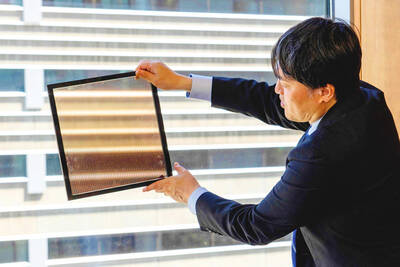The Hong Kong Trade Development Council (HKTDC, 香港貿易發展局) will promote cooperation among small and medium-size enterprises (SMEs) in Taiwan, Hong Kong and China to tap into the vast Chinese market, the head of the council’s Taipei office said on Friday.
Perry Fung (馮渤) made the pledge at a cocktail reception marking the opening of the HKTDC Taiwan office, which will formally become operational early next year.
Fung said that China already had a middle-class population of 230 million, adding that the Chinese consumer market was worth developing and that there was ample room for SMEs in the three Chinese-speaking societies to cooperate in exploring such an immense opportunity.
Senior HKTDC executives also traveled to Taipei to attend the opening reception, which saw the attendance of many Taiwanese trade promoters and business managers, including Wang Chih-kang (王志剛), chairman of the Taiwan External Trade Development Council (TAITRA, 外貿協會).
GROWING CLOSER
HKTDC Chairman Jack So (蘇澤光) said that capital, commodity and manpower exchanges among Taiwan, China and Hong Kong will grow ever closer.
Against this backdrop, So said the HKTDC decided to open a branch in Taipei to facilitate further cooperation.
The HKTDC, a Hong Kong government-funded but unofficial organization, began considering opening a branch in Taiwan five years ago, but did not file an application until after the Chinese Nationalist Party (KMT) — seen as more friendly toward China than the previous administration — regained power this year.
After the Ministry of Economic Affairs approved the HKTDC application in October, the Hong Kong group sent Fung — formerly the HKTDC Beijing office’s top executive in charge of the northern China market — to Taipei to prepare for the opening of the new office.
STATISTICS
Hong Kong is Taiwan’s fourth-largest trading partner after China, Japan and the US.
Customs statistics show that Taiwan-Hong Kong trade totaled US$39.8 billion last year, accounting for 8.54 percent of overall foreign trade. Taiwan’s exports accounted for US$37.98 billion, or 15.4 percent of the country’s total exports, making Hong Kong its second-largest export outlet.
At the same time, Hong Kong invested more than US$200 million in Taiwan, up 76 percent from 2006, while Taiwan’s investment in Hong Kong for that year totaled about US$190 million.
In the first six months of this year, Hong Kong investment had already topped US$236 million, far exceeding its investment for all of last year, government tallies showed.

UNCERTAINTIES: Exports surged 34.1% and private investment grew 7.03% to outpace expectations in the first half, although US tariffs could stall momentum The Chung-Hua Institution for Economic Research (CIER, 中華經濟研究院) yesterday raised its GDP growth forecast to 3.05 percent this year on a robust first-half performance, but warned that US tariff threats and external uncertainty could stall momentum in the second half of the year. “The first half proved exceptionally strong, allowing room for optimism,” CIER president Lien Hsien-ming (連賢明) said. “But the growth momentum may slow moving forward due to US tariffs.” The tariff threat poses definite downside risks, although the scale of the impact remains unclear given the unpredictability of US President Donald Trump’s policies, Lien said. Despite the headwinds, Taiwan is likely

When Lika Megreladze was a child, life in her native western Georgian region of Guria revolved around tea. Her mother worked for decades as a scientist at the Soviet Union’s Institute of Tea and Subtropical Crops in the village of Anaseuli, Georgia, perfecting cultivation methods for a Georgian tea industry that supplied the bulk of the vast communist state’s brews. “When I was a child, this was only my mum’s workplace. Only later I realized that it was something big,” she said. Now, the institute lies abandoned. Yellowed papers are strewn around its decaying corridors, and a statue of Soviet founder Vladimir Lenin

UNIFYING OPPOSITION: Numerous companies have registered complaints over the potential levies, bringing together rival automakers in voicing their reservations US President Donald Trump is readying plans for industry-specific tariffs to kick in alongside his country-by-country duties in two weeks, ramping up his push to reshape the US’ standing in the global trading system by penalizing purchases from abroad. Administration officials could release details of Trump’s planned 50 percent duty on copper in the days before they are set to take effect on Friday next week, a person familiar with the matter said. That is the same date Trump’s “reciprocal” levies on products from more than 100 nations are slated to begin. Trump on Tuesday said that he is likely to impose tariffs

Japan is heavily investing in a new kind of ultra-thin, flexible solar panel that it hopes will help it meet renewable energy goals while challenging China’s dominance of the sector. Pliable perovskite panels are perfect for mountainous Japan, with its shortage of flat plots for traditional solar farms. A key component of the panels is iodine, something Japan produces more of than any country but Chile. The push faces some obstacles: Perovskite panels contain toxic lead, and, for now, produce less power and have shorter lifespans than their silicon counterparts. Still, with a goal of net zero by 2050 and a desire to